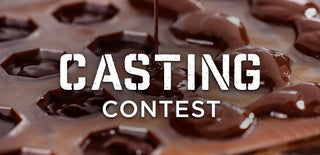Introduction: USB Foam Cutter
Foam is one of the cheapest and most common materials available now. With this tool, you'll be able to slice through foam like a hot knife through butter! With the neat cuts you can make, Styrofoam can now be used to make prototypes, models, or sculptures. However, the main reason I entered this in the Casting Contest (don't forget to vote for me ;) ) is because Styrofoam is cheap and easy to find. With this Foam Cutter, it will also be easy to cut and use for mold making.
This is a relatively simple build that takes advantage of nickel chromium's high electrical resistance to slice through foam. It also operates entirely on low voltage with the powering interface we all know and love(USB-A). This way, just grab a battery bank and slice wherever your mold takes you. I don't recommend plugging this into your computer as PC USB ports only give out ~500mA and that isn't enough current to really heat up the wire. At least 1 ampere of current at 5 volts worked for me though of course it wasn't as fast as my previous 20v 5amp build. Remember that this is a low-power, portable way to cut foam and can be adapted and improved to fit niche purposes.
Look above for a video of what we'll be building in action!
Let's get started!
Step 1: Gather Materials
When I first learned about nickel chromium's amazing (to me at least) properties, I immediately came up with a bunch of fun projects to use it in. I also had just won an amazon gift card at a hackathon. That's why instead of foraging and harvesting it from different places like toasters and hair dryers, I ordered 350 feet from Amazon for $9.99. I actually ordered 700 feet so enamored was I with it. Anyways, you'll need at least 1 foot of it for this, try to get close to the gauge I got as I haven't done the math for smaller or larger wire diameters.
FULL LIST
-1 ft Nichrome
-Aluminum or copper wire
-USB A wire
-7 chopsticks
-2 small wire nuts
-Duct Tape
-Hot Glue
Step 2: Build the Frame
Place two of your chopsticks parallel to each other about a chopstick's length away like shown in the images. Sandwich the ends with two more chopsticks and secure with either wood glue or hot glue. It doesn't have to be the strongest, just solid enough to hold the shape as we'll be adding duct tape to the joints later.
Next, secure a couple of chopsticks at an angle about three fifths of the way up to act as supporting structures. Remember to add glue to the top parts and the parts that will end up sandwiched between the other chopsticks as shown in the images above.
Step 3: Adding the Electrical Components
To add the nickel chromium, I split the top part of the two parallel chopsticks in half and threaded the wire through the middle. Make sure each chopstick has the same amount of extra material (should be a little over an inch) to secure the wire on the sticks. Now wrap some of the aluminum or copper wire around the top part and thread your nichrome wire around the coil to further secure it. The coil around it will act as both a contact point and a heat sink. If you skip this step and hook up the nickel chromium directly to your USB cable, it will heat up and the plastic surrounding it will melt. That is why I suggest you use relatively thick aluminum wire as it is cheaper than copper but still a good choice for a heat sink. I only coiled mine for about an inch of each chopstick, but you can do more if you will be using it for longer periods of time (more than 45 minutes of being continuously plugged in).
For the contact part of our contact/heat sink, use pliers to bend a loop in a wire (I used copper) and attach it to the aluminum coil we just made like shown in the image. Then close the end tightly and solder if you wish. Note that this isn't necessary. Now repeat the above steps on the other side.
Lastly, take your wire and connect it to the USB-A cable. I used wire nuts because I may need the cable later for another project, but feel free to solder them together. Also, add a chopstick in the middle to stretch out the chopsticks on the ends holding your wire so that the wire becomes as straight as possible.
Step 4: Understanding How It Works
The high electrical resistance of nickel chromium wire makes it harder for electrons to pass through. If given the option, they will go through a less resistive wire like iron, aluminum, or copper. Because it is highly resistive, it heats up as electrons fight their way through the other side. This device concentrates the heat in a single strand of the wire to melt foam to make clean cuts. Think of it like a laser cutter. Because the temperature needed to melt Styrofoam is high compared to ambient temperatures, the aluminum heat sinks prevent the nichrome wire's heat from traveling up the circuit into the USB-A cable and your battery.
Now that you know how this works, get to cutting and share the sculptures or molds you make with this!

Participated in the
Casting Contest











